Human Resource Management Literature Review
VerifiedAdded on 2020/02/05
|15
|4067
|333
AI Summary
This assignment requires a comprehensive literature review on human resource management (HRM). Students are expected to analyze existing research and theories related to HRM practices, their effectiveness, and their influence on organizational success. The review should draw upon a range of academic sources such as books, journal articles, and online publications.
Contribute Materials
Your contribution can guide someone’s learning journey. Share your
documents today.
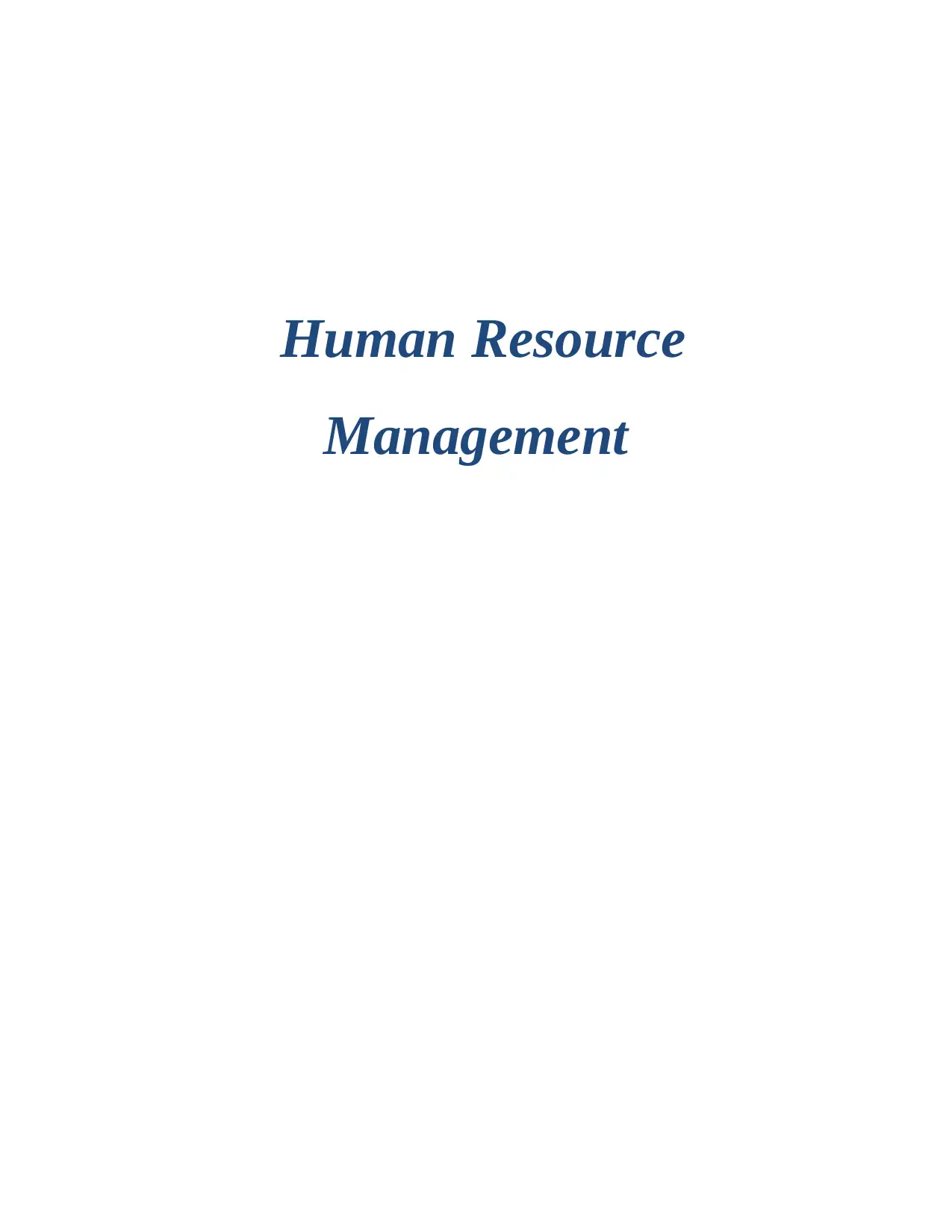
Human Resource
Management
Management
Secure Best Marks with AI Grader
Need help grading? Try our AI Grader for instant feedback on your assignments.
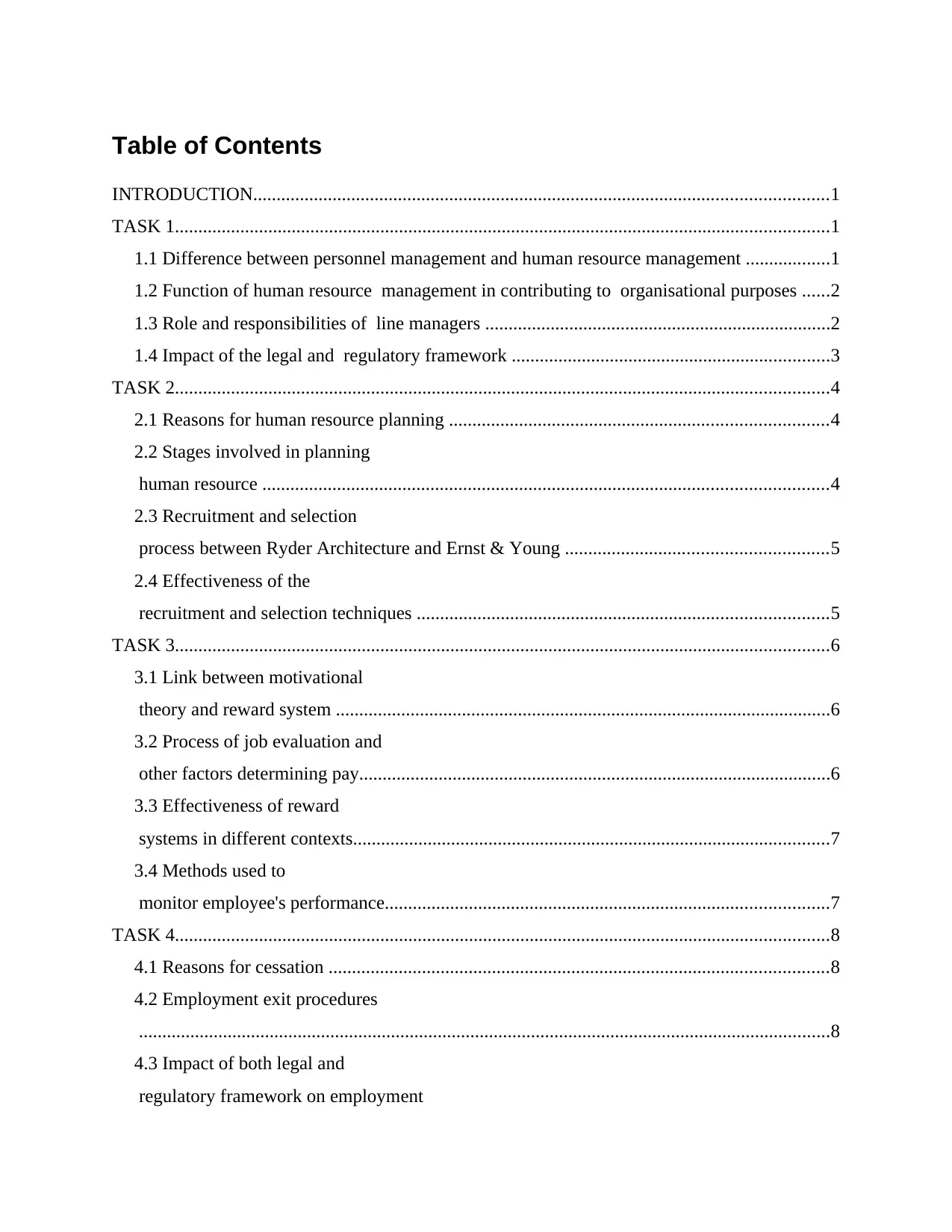
Table of Contents
INTRODUCTION...........................................................................................................................1
TASK 1............................................................................................................................................1
1.1 Difference between personnel management and human resource management ..................1
1.2 Function of human resource management in contributing to organisational purposes ......2
1.3 Role and responsibilities of line managers ..........................................................................2
1.4 Impact of the legal and regulatory framework ....................................................................3
TASK 2............................................................................................................................................4
2.1 Reasons for human resource planning .................................................................................4
2.2 Stages involved in planning
human resource .........................................................................................................................4
2.3 Recruitment and selection
process between Ryder Architecture and Ernst & Young ........................................................5
2.4 Effectiveness of the
recruitment and selection techniques ........................................................................................5
TASK 3............................................................................................................................................6
3.1 Link between motivational
theory and reward system ..........................................................................................................6
3.2 Process of job evaluation and
other factors determining pay.....................................................................................................6
3.3 Effectiveness of reward
systems in different contexts......................................................................................................7
3.4 Methods used to
monitor employee's performance...............................................................................................7
TASK 4............................................................................................................................................8
4.1 Reasons for cessation ...........................................................................................................8
4.2 Employment exit procedures
....................................................................................................................................................8
4.3 Impact of both legal and
regulatory framework on employment
INTRODUCTION...........................................................................................................................1
TASK 1............................................................................................................................................1
1.1 Difference between personnel management and human resource management ..................1
1.2 Function of human resource management in contributing to organisational purposes ......2
1.3 Role and responsibilities of line managers ..........................................................................2
1.4 Impact of the legal and regulatory framework ....................................................................3
TASK 2............................................................................................................................................4
2.1 Reasons for human resource planning .................................................................................4
2.2 Stages involved in planning
human resource .........................................................................................................................4
2.3 Recruitment and selection
process between Ryder Architecture and Ernst & Young ........................................................5
2.4 Effectiveness of the
recruitment and selection techniques ........................................................................................5
TASK 3............................................................................................................................................6
3.1 Link between motivational
theory and reward system ..........................................................................................................6
3.2 Process of job evaluation and
other factors determining pay.....................................................................................................6
3.3 Effectiveness of reward
systems in different contexts......................................................................................................7
3.4 Methods used to
monitor employee's performance...............................................................................................7
TASK 4............................................................................................................................................8
4.1 Reasons for cessation ...........................................................................................................8
4.2 Employment exit procedures
....................................................................................................................................................8
4.3 Impact of both legal and
regulatory framework on employment
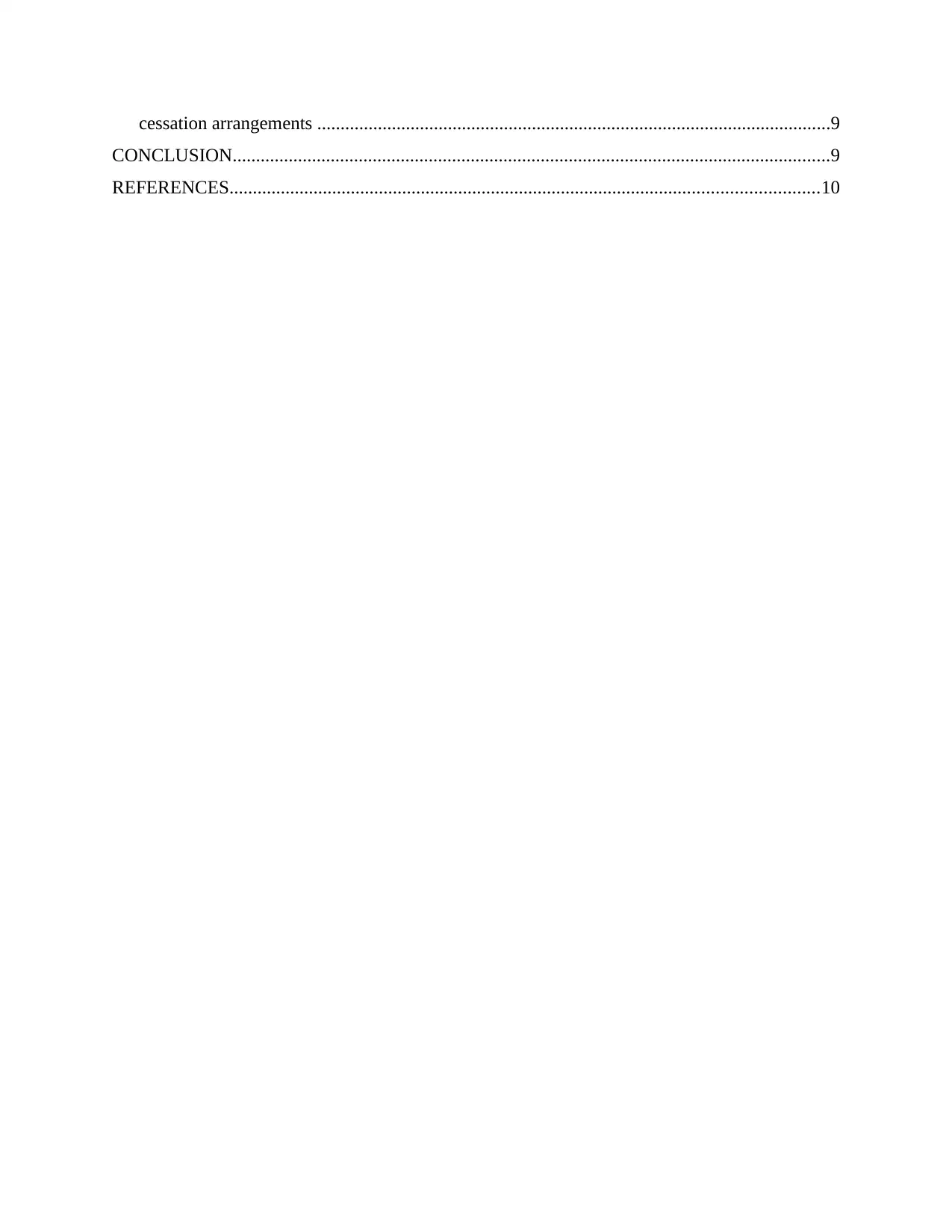
cessation arrangements ..............................................................................................................9
CONCLUSION................................................................................................................................9
REFERENCES..............................................................................................................................10
CONCLUSION................................................................................................................................9
REFERENCES..............................................................................................................................10
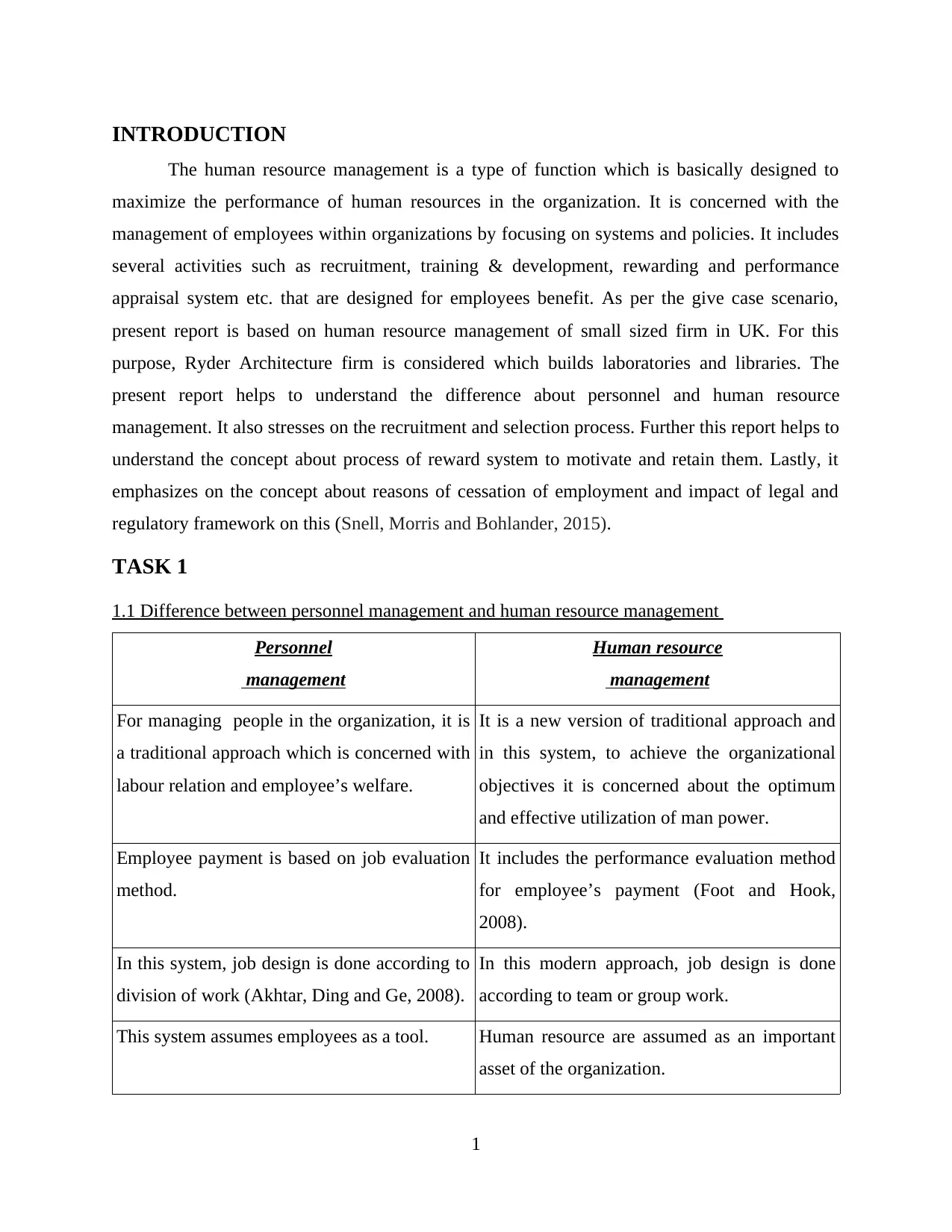
INTRODUCTION
The human resource management is a type of function which is basically designed to
maximize the performance of human resources in the organization. It is concerned with the
management of employees within organizations by focusing on systems and policies. It includes
several activities such as recruitment, training & development, rewarding and performance
appraisal system etc. that are designed for employees benefit. As per the give case scenario,
present report is based on human resource management of small sized firm in UK. For this
purpose, Ryder Architecture firm is considered which builds laboratories and libraries. The
present report helps to understand the difference about personnel and human resource
management. It also stresses on the recruitment and selection process. Further this report helps to
understand the concept about process of reward system to motivate and retain them. Lastly, it
emphasizes on the concept about reasons of cessation of employment and impact of legal and
regulatory framework on this (Snell, Morris and Bohlander, 2015).
TASK 1
1.1 Difference between personnel management and human resource management
Personnel
management
Human resource
management
For managing people in the organization, it is
a traditional approach which is concerned with
labour relation and employee’s welfare.
It is a new version of traditional approach and
in this system, to achieve the organizational
objectives it is concerned about the optimum
and effective utilization of man power.
Employee payment is based on job evaluation
method.
It includes the performance evaluation method
for employee’s payment (Foot and Hook,
2008).
In this system, job design is done according to
division of work (Akhtar, Ding and Ge, 2008).
In this modern approach, job design is done
according to team or group work.
This system assumes employees as a tool. Human resource are assumed as an important
asset of the organization.
1
The human resource management is a type of function which is basically designed to
maximize the performance of human resources in the organization. It is concerned with the
management of employees within organizations by focusing on systems and policies. It includes
several activities such as recruitment, training & development, rewarding and performance
appraisal system etc. that are designed for employees benefit. As per the give case scenario,
present report is based on human resource management of small sized firm in UK. For this
purpose, Ryder Architecture firm is considered which builds laboratories and libraries. The
present report helps to understand the difference about personnel and human resource
management. It also stresses on the recruitment and selection process. Further this report helps to
understand the concept about process of reward system to motivate and retain them. Lastly, it
emphasizes on the concept about reasons of cessation of employment and impact of legal and
regulatory framework on this (Snell, Morris and Bohlander, 2015).
TASK 1
1.1 Difference between personnel management and human resource management
Personnel
management
Human resource
management
For managing people in the organization, it is
a traditional approach which is concerned with
labour relation and employee’s welfare.
It is a new version of traditional approach and
in this system, to achieve the organizational
objectives it is concerned about the optimum
and effective utilization of man power.
Employee payment is based on job evaluation
method.
It includes the performance evaluation method
for employee’s payment (Foot and Hook,
2008).
In this system, job design is done according to
division of work (Akhtar, Ding and Ge, 2008).
In this modern approach, job design is done
according to team or group work.
This system assumes employees as a tool. Human resource are assumed as an important
asset of the organization.
1
Secure Best Marks with AI Grader
Need help grading? Try our AI Grader for instant feedback on your assignments.
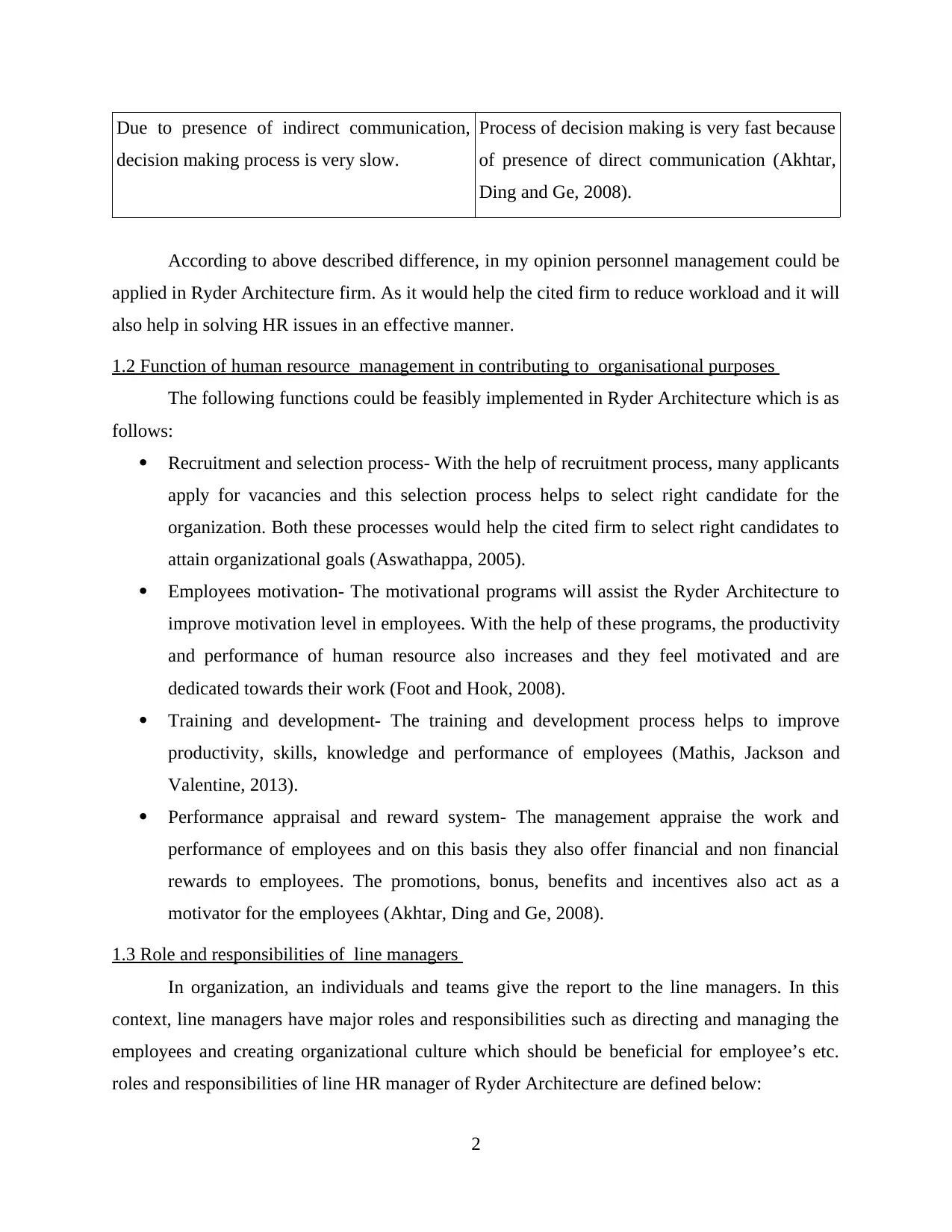
Due to presence of indirect communication,
decision making process is very slow.
Process of decision making is very fast because
of presence of direct communication (Akhtar,
Ding and Ge, 2008).
According to above described difference, in my opinion personnel management could be
applied in Ryder Architecture firm. As it would help the cited firm to reduce workload and it will
also help in solving HR issues in an effective manner.
1.2 Function of human resource management in contributing to organisational purposes
The following functions could be feasibly implemented in Ryder Architecture which is as
follows:
Recruitment and selection process- With the help of recruitment process, many applicants
apply for vacancies and this selection process helps to select right candidate for the
organization. Both these processes would help the cited firm to select right candidates to
attain organizational goals (Aswathappa, 2005).
Employees motivation- The motivational programs will assist the Ryder Architecture to
improve motivation level in employees. With the help of these programs, the productivity
and performance of human resource also increases and they feel motivated and are
dedicated towards their work (Foot and Hook, 2008).
Training and development- The training and development process helps to improve
productivity, skills, knowledge and performance of employees (Mathis, Jackson and
Valentine, 2013).
Performance appraisal and reward system- The management appraise the work and
performance of employees and on this basis they also offer financial and non financial
rewards to employees. The promotions, bonus, benefits and incentives also act as a
motivator for the employees (Akhtar, Ding and Ge, 2008).
1.3 Role and responsibilities of line managers
In organization, an individuals and teams give the report to the line managers. In this
context, line managers have major roles and responsibilities such as directing and managing the
employees and creating organizational culture which should be beneficial for employee’s etc.
roles and responsibilities of line HR manager of Ryder Architecture are defined below:
2
decision making process is very slow.
Process of decision making is very fast because
of presence of direct communication (Akhtar,
Ding and Ge, 2008).
According to above described difference, in my opinion personnel management could be
applied in Ryder Architecture firm. As it would help the cited firm to reduce workload and it will
also help in solving HR issues in an effective manner.
1.2 Function of human resource management in contributing to organisational purposes
The following functions could be feasibly implemented in Ryder Architecture which is as
follows:
Recruitment and selection process- With the help of recruitment process, many applicants
apply for vacancies and this selection process helps to select right candidate for the
organization. Both these processes would help the cited firm to select right candidates to
attain organizational goals (Aswathappa, 2005).
Employees motivation- The motivational programs will assist the Ryder Architecture to
improve motivation level in employees. With the help of these programs, the productivity
and performance of human resource also increases and they feel motivated and are
dedicated towards their work (Foot and Hook, 2008).
Training and development- The training and development process helps to improve
productivity, skills, knowledge and performance of employees (Mathis, Jackson and
Valentine, 2013).
Performance appraisal and reward system- The management appraise the work and
performance of employees and on this basis they also offer financial and non financial
rewards to employees. The promotions, bonus, benefits and incentives also act as a
motivator for the employees (Akhtar, Ding and Ge, 2008).
1.3 Role and responsibilities of line managers
In organization, an individuals and teams give the report to the line managers. In this
context, line managers have major roles and responsibilities such as directing and managing the
employees and creating organizational culture which should be beneficial for employee’s etc.
roles and responsibilities of line HR manager of Ryder Architecture are defined below:
2
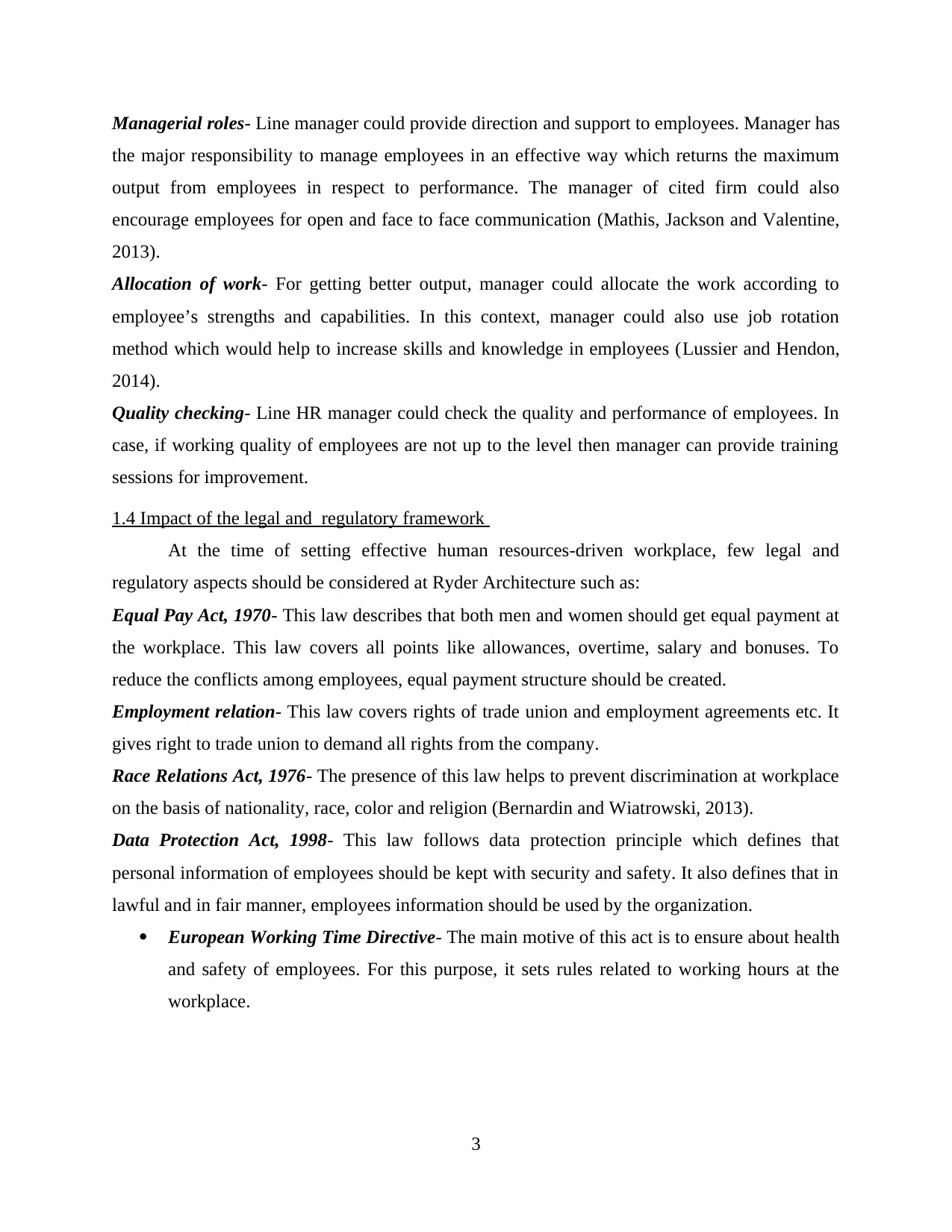
Managerial roles- Line manager could provide direction and support to employees. Manager has
the major responsibility to manage employees in an effective way which returns the maximum
output from employees in respect to performance. The manager of cited firm could also
encourage employees for open and face to face communication (Mathis, Jackson and Valentine,
2013).
Allocation of work- For getting better output, manager could allocate the work according to
employee’s strengths and capabilities. In this context, manager could also use job rotation
method which would help to increase skills and knowledge in employees (Lussier and Hendon,
2014).
Quality checking- Line HR manager could check the quality and performance of employees. In
case, if working quality of employees are not up to the level then manager can provide training
sessions for improvement.
1.4 Impact of the legal and regulatory framework
At the time of setting effective human resources-driven workplace, few legal and
regulatory aspects should be considered at Ryder Architecture such as:
Equal Pay Act, 1970- This law describes that both men and women should get equal payment at
the workplace. This law covers all points like allowances, overtime, salary and bonuses. To
reduce the conflicts among employees, equal payment structure should be created.
Employment relation- This law covers rights of trade union and employment agreements etc. It
gives right to trade union to demand all rights from the company.
Race Relations Act, 1976- The presence of this law helps to prevent discrimination at workplace
on the basis of nationality, race, color and religion (Bernardin and Wiatrowski, 2013).
Data Protection Act, 1998- This law follows data protection principle which defines that
personal information of employees should be kept with security and safety. It also defines that in
lawful and in fair manner, employees information should be used by the organization.
European Working Time Directive- The main motive of this act is to ensure about health
and safety of employees. For this purpose, it sets rules related to working hours at the
workplace.
3
the major responsibility to manage employees in an effective way which returns the maximum
output from employees in respect to performance. The manager of cited firm could also
encourage employees for open and face to face communication (Mathis, Jackson and Valentine,
2013).
Allocation of work- For getting better output, manager could allocate the work according to
employee’s strengths and capabilities. In this context, manager could also use job rotation
method which would help to increase skills and knowledge in employees (Lussier and Hendon,
2014).
Quality checking- Line HR manager could check the quality and performance of employees. In
case, if working quality of employees are not up to the level then manager can provide training
sessions for improvement.
1.4 Impact of the legal and regulatory framework
At the time of setting effective human resources-driven workplace, few legal and
regulatory aspects should be considered at Ryder Architecture such as:
Equal Pay Act, 1970- This law describes that both men and women should get equal payment at
the workplace. This law covers all points like allowances, overtime, salary and bonuses. To
reduce the conflicts among employees, equal payment structure should be created.
Employment relation- This law covers rights of trade union and employment agreements etc. It
gives right to trade union to demand all rights from the company.
Race Relations Act, 1976- The presence of this law helps to prevent discrimination at workplace
on the basis of nationality, race, color and religion (Bernardin and Wiatrowski, 2013).
Data Protection Act, 1998- This law follows data protection principle which defines that
personal information of employees should be kept with security and safety. It also defines that in
lawful and in fair manner, employees information should be used by the organization.
European Working Time Directive- The main motive of this act is to ensure about health
and safety of employees. For this purpose, it sets rules related to working hours at the
workplace.
3
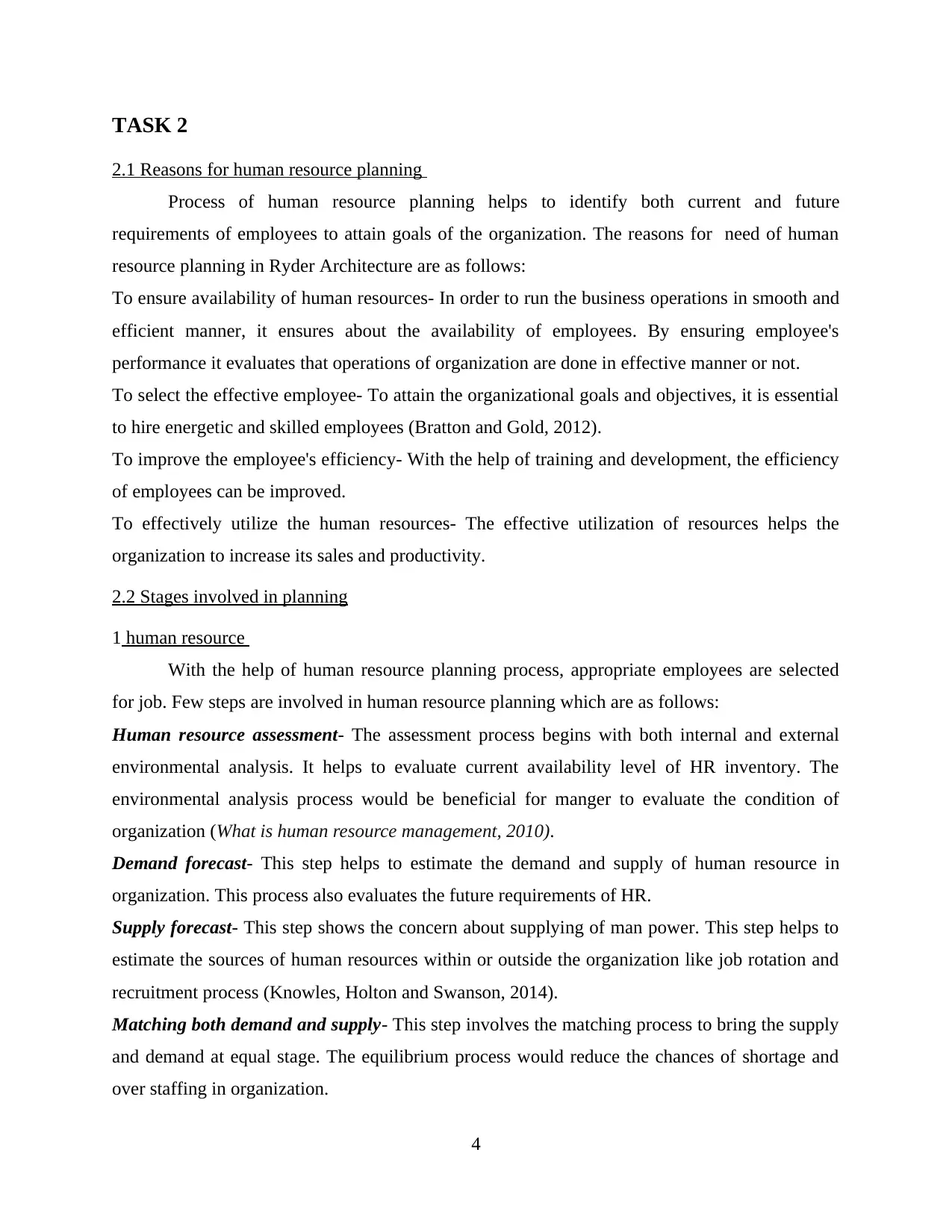
TASK 2
2.1 Reasons for human resource planning
Process of human resource planning helps to identify both current and future
requirements of employees to attain goals of the organization. The reasons for need of human
resource planning in Ryder Architecture are as follows:
To ensure availability of human resources- In order to run the business operations in smooth and
efficient manner, it ensures about the availability of employees. By ensuring employee's
performance it evaluates that operations of organization are done in effective manner or not.
To select the effective employee- To attain the organizational goals and objectives, it is essential
to hire energetic and skilled employees (Bratton and Gold, 2012).
To improve the employee's efficiency- With the help of training and development, the efficiency
of employees can be improved.
To effectively utilize the human resources- The effective utilization of resources helps the
organization to increase its sales and productivity.
2.2 Stages involved in planning
1 human resource
With the help of human resource planning process, appropriate employees are selected
for job. Few steps are involved in human resource planning which are as follows:
Human resource assessment- The assessment process begins with both internal and external
environmental analysis. It helps to evaluate current availability level of HR inventory. The
environmental analysis process would be beneficial for manger to evaluate the condition of
organization (What is human resource management, 2010).
Demand forecast- This step helps to estimate the demand and supply of human resource in
organization. This process also evaluates the future requirements of HR.
Supply forecast- This step shows the concern about supplying of man power. This step helps to
estimate the sources of human resources within or outside the organization like job rotation and
recruitment process (Knowles, Holton and Swanson, 2014).
Matching both demand and supply- This step involves the matching process to bring the supply
and demand at equal stage. The equilibrium process would reduce the chances of shortage and
over staffing in organization.
4
2.1 Reasons for human resource planning
Process of human resource planning helps to identify both current and future
requirements of employees to attain goals of the organization. The reasons for need of human
resource planning in Ryder Architecture are as follows:
To ensure availability of human resources- In order to run the business operations in smooth and
efficient manner, it ensures about the availability of employees. By ensuring employee's
performance it evaluates that operations of organization are done in effective manner or not.
To select the effective employee- To attain the organizational goals and objectives, it is essential
to hire energetic and skilled employees (Bratton and Gold, 2012).
To improve the employee's efficiency- With the help of training and development, the efficiency
of employees can be improved.
To effectively utilize the human resources- The effective utilization of resources helps the
organization to increase its sales and productivity.
2.2 Stages involved in planning
1 human resource
With the help of human resource planning process, appropriate employees are selected
for job. Few steps are involved in human resource planning which are as follows:
Human resource assessment- The assessment process begins with both internal and external
environmental analysis. It helps to evaluate current availability level of HR inventory. The
environmental analysis process would be beneficial for manger to evaluate the condition of
organization (What is human resource management, 2010).
Demand forecast- This step helps to estimate the demand and supply of human resource in
organization. This process also evaluates the future requirements of HR.
Supply forecast- This step shows the concern about supplying of man power. This step helps to
estimate the sources of human resources within or outside the organization like job rotation and
recruitment process (Knowles, Holton and Swanson, 2014).
Matching both demand and supply- This step involves the matching process to bring the supply
and demand at equal stage. The equilibrium process would reduce the chances of shortage and
over staffing in organization.
4
Paraphrase This Document
Need a fresh take? Get an instant paraphrase of this document with our AI Paraphraser
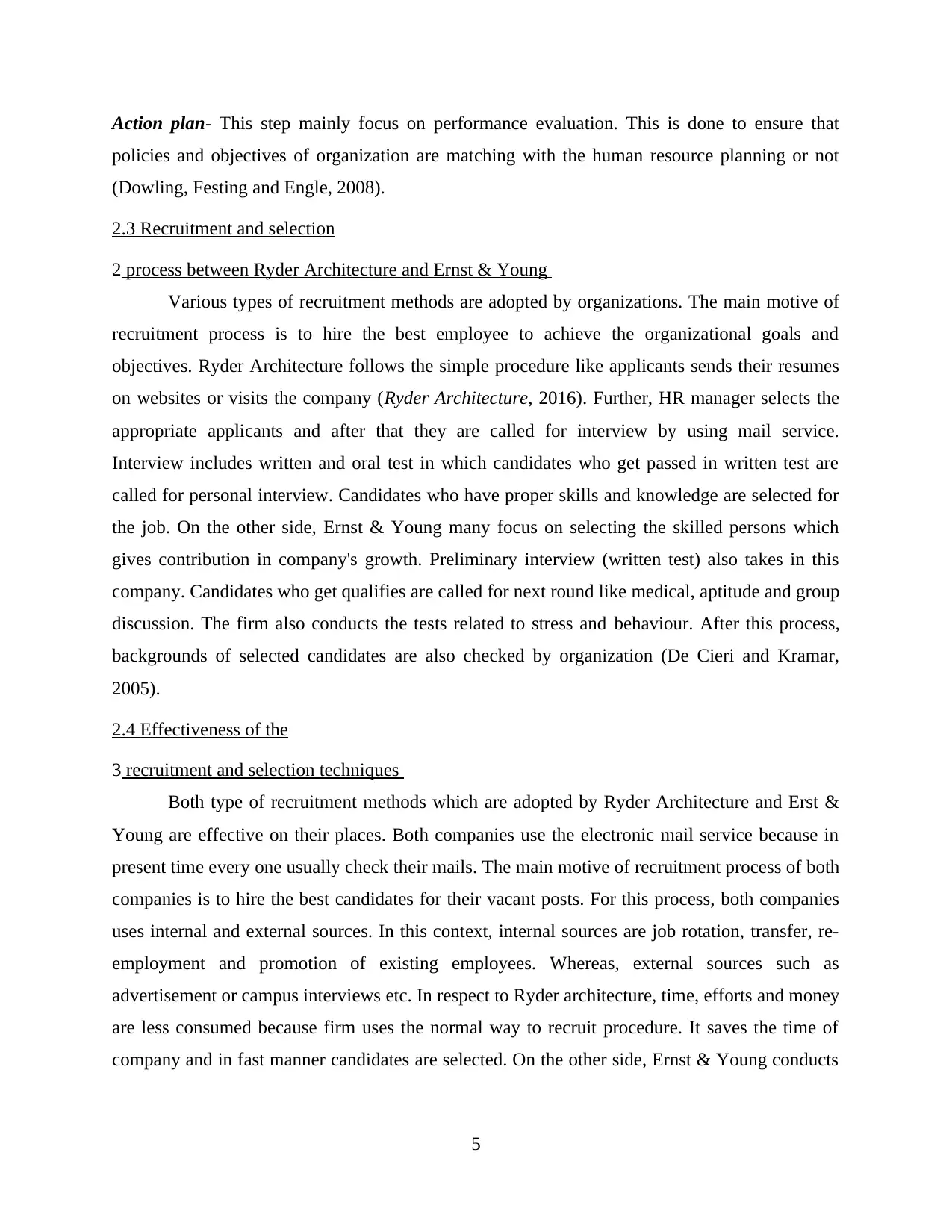
Action plan- This step mainly focus on performance evaluation. This is done to ensure that
policies and objectives of organization are matching with the human resource planning or not
(Dowling, Festing and Engle, 2008).
2.3 Recruitment and selection
2 process between Ryder Architecture and Ernst & Young
Various types of recruitment methods are adopted by organizations. The main motive of
recruitment process is to hire the best employee to achieve the organizational goals and
objectives. Ryder Architecture follows the simple procedure like applicants sends their resumes
on websites or visits the company (Ryder Architecture, 2016). Further, HR manager selects the
appropriate applicants and after that they are called for interview by using mail service.
Interview includes written and oral test in which candidates who get passed in written test are
called for personal interview. Candidates who have proper skills and knowledge are selected for
the job. On the other side, Ernst & Young many focus on selecting the skilled persons which
gives contribution in company's growth. Preliminary interview (written test) also takes in this
company. Candidates who get qualifies are called for next round like medical, aptitude and group
discussion. The firm also conducts the tests related to stress and behaviour. After this process,
backgrounds of selected candidates are also checked by organization (De Cieri and Kramar,
2005).
2.4 Effectiveness of the
3 recruitment and selection techniques
Both type of recruitment methods which are adopted by Ryder Architecture and Erst &
Young are effective on their places. Both companies use the electronic mail service because in
present time every one usually check their mails. The main motive of recruitment process of both
companies is to hire the best candidates for their vacant posts. For this process, both companies
uses internal and external sources. In this context, internal sources are job rotation, transfer, re-
employment and promotion of existing employees. Whereas, external sources such as
advertisement or campus interviews etc. In respect to Ryder architecture, time, efforts and money
are less consumed because firm uses the normal way to recruit procedure. It saves the time of
company and in fast manner candidates are selected. On the other side, Ernst & Young conducts
5
policies and objectives of organization are matching with the human resource planning or not
(Dowling, Festing and Engle, 2008).
2.3 Recruitment and selection
2 process between Ryder Architecture and Ernst & Young
Various types of recruitment methods are adopted by organizations. The main motive of
recruitment process is to hire the best employee to achieve the organizational goals and
objectives. Ryder Architecture follows the simple procedure like applicants sends their resumes
on websites or visits the company (Ryder Architecture, 2016). Further, HR manager selects the
appropriate applicants and after that they are called for interview by using mail service.
Interview includes written and oral test in which candidates who get passed in written test are
called for personal interview. Candidates who have proper skills and knowledge are selected for
the job. On the other side, Ernst & Young many focus on selecting the skilled persons which
gives contribution in company's growth. Preliminary interview (written test) also takes in this
company. Candidates who get qualifies are called for next round like medical, aptitude and group
discussion. The firm also conducts the tests related to stress and behaviour. After this process,
backgrounds of selected candidates are also checked by organization (De Cieri and Kramar,
2005).
2.4 Effectiveness of the
3 recruitment and selection techniques
Both type of recruitment methods which are adopted by Ryder Architecture and Erst &
Young are effective on their places. Both companies use the electronic mail service because in
present time every one usually check their mails. The main motive of recruitment process of both
companies is to hire the best candidates for their vacant posts. For this process, both companies
uses internal and external sources. In this context, internal sources are job rotation, transfer, re-
employment and promotion of existing employees. Whereas, external sources such as
advertisement or campus interviews etc. In respect to Ryder architecture, time, efforts and money
are less consumed because firm uses the normal way to recruit procedure. It saves the time of
company and in fast manner candidates are selected. On the other side, Ernst & Young conducts
5
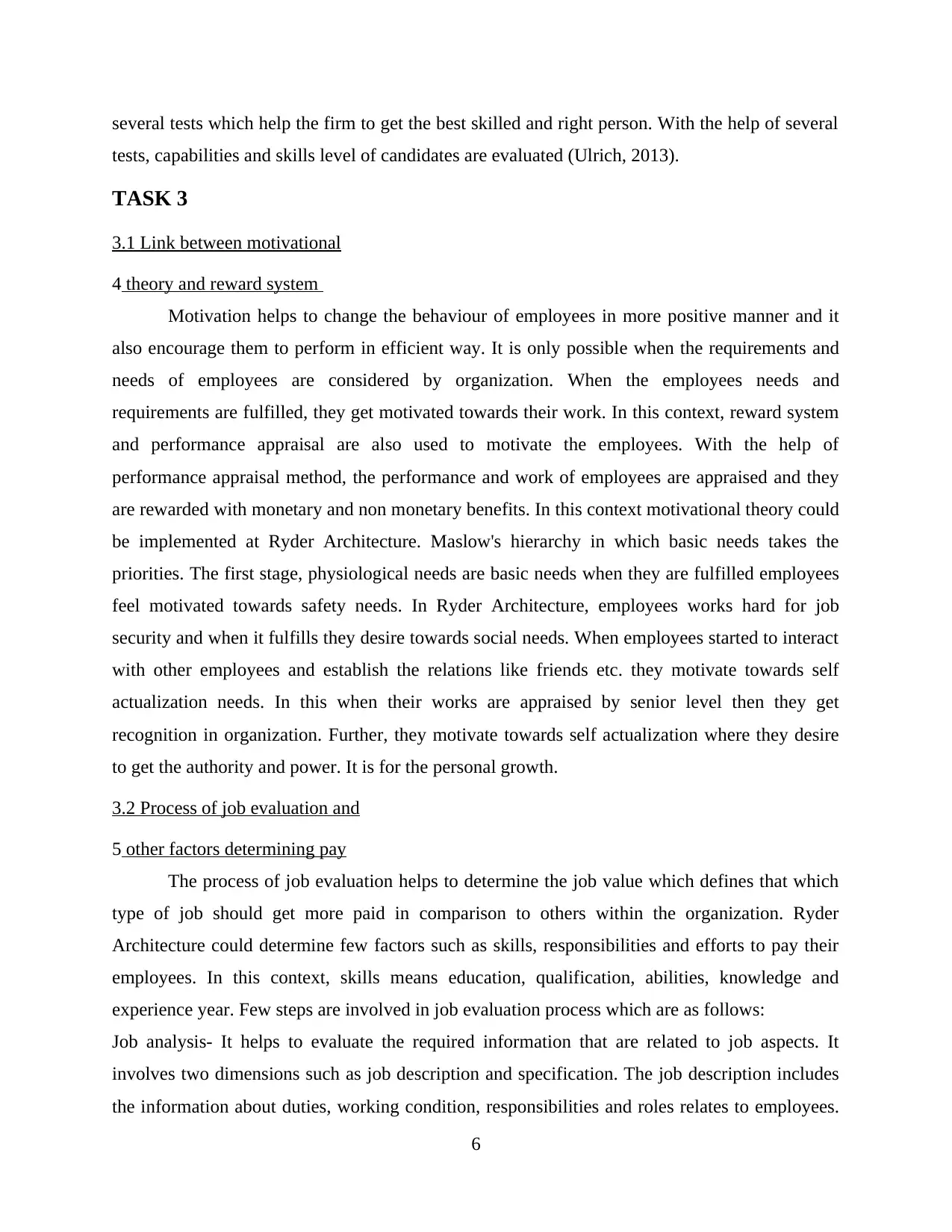
several tests which help the firm to get the best skilled and right person. With the help of several
tests, capabilities and skills level of candidates are evaluated (Ulrich, 2013).
TASK 3
3.1 Link between motivational
4 theory and reward system
Motivation helps to change the behaviour of employees in more positive manner and it
also encourage them to perform in efficient way. It is only possible when the requirements and
needs of employees are considered by organization. When the employees needs and
requirements are fulfilled, they get motivated towards their work. In this context, reward system
and performance appraisal are also used to motivate the employees. With the help of
performance appraisal method, the performance and work of employees are appraised and they
are rewarded with monetary and non monetary benefits. In this context motivational theory could
be implemented at Ryder Architecture. Maslow's hierarchy in which basic needs takes the
priorities. The first stage, physiological needs are basic needs when they are fulfilled employees
feel motivated towards safety needs. In Ryder Architecture, employees works hard for job
security and when it fulfills they desire towards social needs. When employees started to interact
with other employees and establish the relations like friends etc. they motivate towards self
actualization needs. In this when their works are appraised by senior level then they get
recognition in organization. Further, they motivate towards self actualization where they desire
to get the authority and power. It is for the personal growth.
3.2 Process of job evaluation and
5 other factors determining pay
The process of job evaluation helps to determine the job value which defines that which
type of job should get more paid in comparison to others within the organization. Ryder
Architecture could determine few factors such as skills, responsibilities and efforts to pay their
employees. In this context, skills means education, qualification, abilities, knowledge and
experience year. Few steps are involved in job evaluation process which are as follows:
Job analysis- It helps to evaluate the required information that are related to job aspects. It
involves two dimensions such as job description and specification. The job description includes
the information about duties, working condition, responsibilities and roles relates to employees.
6
tests, capabilities and skills level of candidates are evaluated (Ulrich, 2013).
TASK 3
3.1 Link between motivational
4 theory and reward system
Motivation helps to change the behaviour of employees in more positive manner and it
also encourage them to perform in efficient way. It is only possible when the requirements and
needs of employees are considered by organization. When the employees needs and
requirements are fulfilled, they get motivated towards their work. In this context, reward system
and performance appraisal are also used to motivate the employees. With the help of
performance appraisal method, the performance and work of employees are appraised and they
are rewarded with monetary and non monetary benefits. In this context motivational theory could
be implemented at Ryder Architecture. Maslow's hierarchy in which basic needs takes the
priorities. The first stage, physiological needs are basic needs when they are fulfilled employees
feel motivated towards safety needs. In Ryder Architecture, employees works hard for job
security and when it fulfills they desire towards social needs. When employees started to interact
with other employees and establish the relations like friends etc. they motivate towards self
actualization needs. In this when their works are appraised by senior level then they get
recognition in organization. Further, they motivate towards self actualization where they desire
to get the authority and power. It is for the personal growth.
3.2 Process of job evaluation and
5 other factors determining pay
The process of job evaluation helps to determine the job value which defines that which
type of job should get more paid in comparison to others within the organization. Ryder
Architecture could determine few factors such as skills, responsibilities and efforts to pay their
employees. In this context, skills means education, qualification, abilities, knowledge and
experience year. Few steps are involved in job evaluation process which are as follows:
Job analysis- It helps to evaluate the required information that are related to job aspects. It
involves two dimensions such as job description and specification. The job description includes
the information about duties, working condition, responsibilities and roles relates to employees.
6
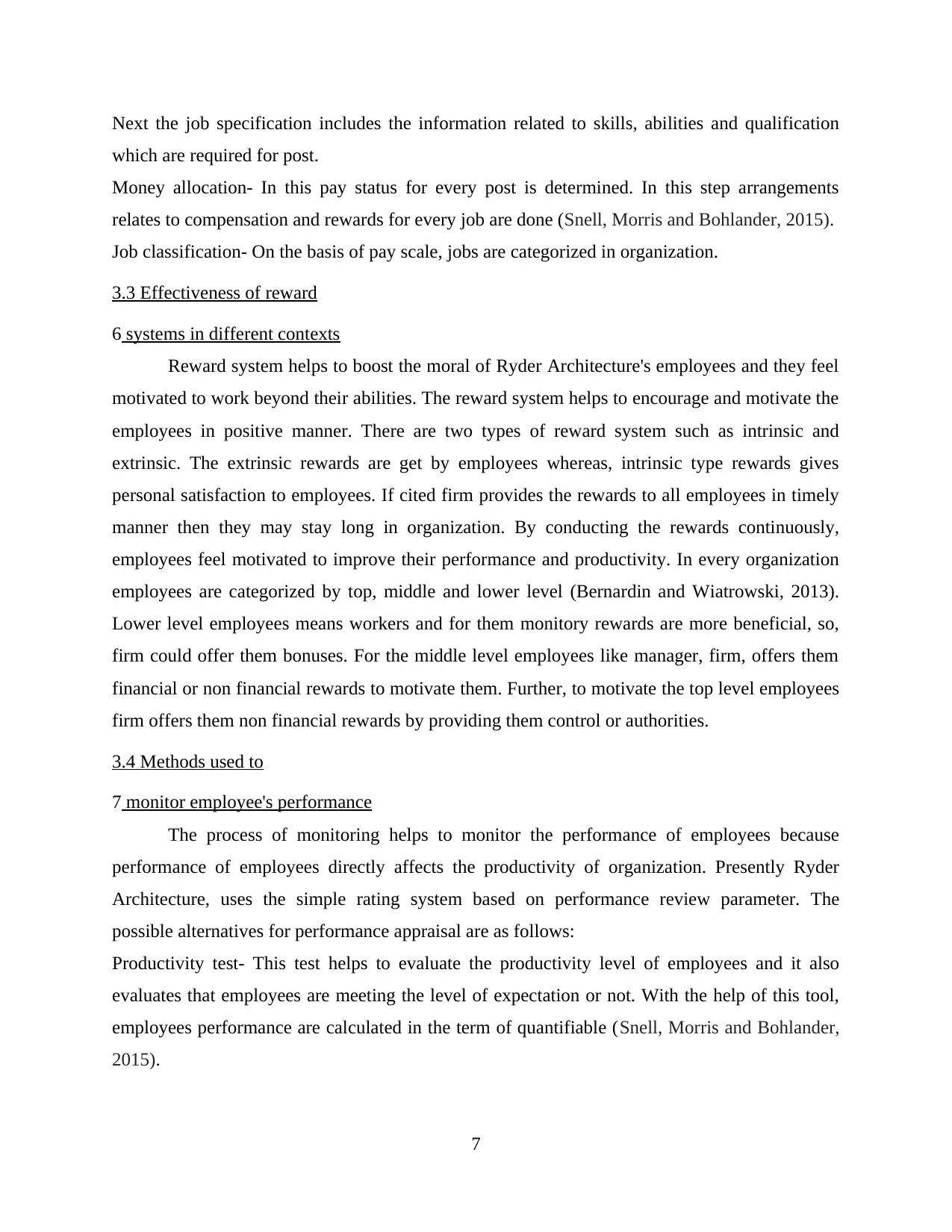
Next the job specification includes the information related to skills, abilities and qualification
which are required for post.
Money allocation- In this pay status for every post is determined. In this step arrangements
relates to compensation and rewards for every job are done (Snell, Morris and Bohlander, 2015).
Job classification- On the basis of pay scale, jobs are categorized in organization.
3.3 Effectiveness of reward
6 systems in different contexts
Reward system helps to boost the moral of Ryder Architecture's employees and they feel
motivated to work beyond their abilities. The reward system helps to encourage and motivate the
employees in positive manner. There are two types of reward system such as intrinsic and
extrinsic. The extrinsic rewards are get by employees whereas, intrinsic type rewards gives
personal satisfaction to employees. If cited firm provides the rewards to all employees in timely
manner then they may stay long in organization. By conducting the rewards continuously,
employees feel motivated to improve their performance and productivity. In every organization
employees are categorized by top, middle and lower level (Bernardin and Wiatrowski, 2013).
Lower level employees means workers and for them monitory rewards are more beneficial, so,
firm could offer them bonuses. For the middle level employees like manager, firm, offers them
financial or non financial rewards to motivate them. Further, to motivate the top level employees
firm offers them non financial rewards by providing them control or authorities.
3.4 Methods used to
7 monitor employee's performance
The process of monitoring helps to monitor the performance of employees because
performance of employees directly affects the productivity of organization. Presently Ryder
Architecture, uses the simple rating system based on performance review parameter. The
possible alternatives for performance appraisal are as follows:
Productivity test- This test helps to evaluate the productivity level of employees and it also
evaluates that employees are meeting the level of expectation or not. With the help of this tool,
employees performance are calculated in the term of quantifiable (Snell, Morris and Bohlander,
2015).
7
which are required for post.
Money allocation- In this pay status for every post is determined. In this step arrangements
relates to compensation and rewards for every job are done (Snell, Morris and Bohlander, 2015).
Job classification- On the basis of pay scale, jobs are categorized in organization.
3.3 Effectiveness of reward
6 systems in different contexts
Reward system helps to boost the moral of Ryder Architecture's employees and they feel
motivated to work beyond their abilities. The reward system helps to encourage and motivate the
employees in positive manner. There are two types of reward system such as intrinsic and
extrinsic. The extrinsic rewards are get by employees whereas, intrinsic type rewards gives
personal satisfaction to employees. If cited firm provides the rewards to all employees in timely
manner then they may stay long in organization. By conducting the rewards continuously,
employees feel motivated to improve their performance and productivity. In every organization
employees are categorized by top, middle and lower level (Bernardin and Wiatrowski, 2013).
Lower level employees means workers and for them monitory rewards are more beneficial, so,
firm could offer them bonuses. For the middle level employees like manager, firm, offers them
financial or non financial rewards to motivate them. Further, to motivate the top level employees
firm offers them non financial rewards by providing them control or authorities.
3.4 Methods used to
7 monitor employee's performance
The process of monitoring helps to monitor the performance of employees because
performance of employees directly affects the productivity of organization. Presently Ryder
Architecture, uses the simple rating system based on performance review parameter. The
possible alternatives for performance appraisal are as follows:
Productivity test- This test helps to evaluate the productivity level of employees and it also
evaluates that employees are meeting the level of expectation or not. With the help of this tool,
employees performance are calculated in the term of quantifiable (Snell, Morris and Bohlander,
2015).
7
Secure Best Marks with AI Grader
Need help grading? Try our AI Grader for instant feedback on your assignments.
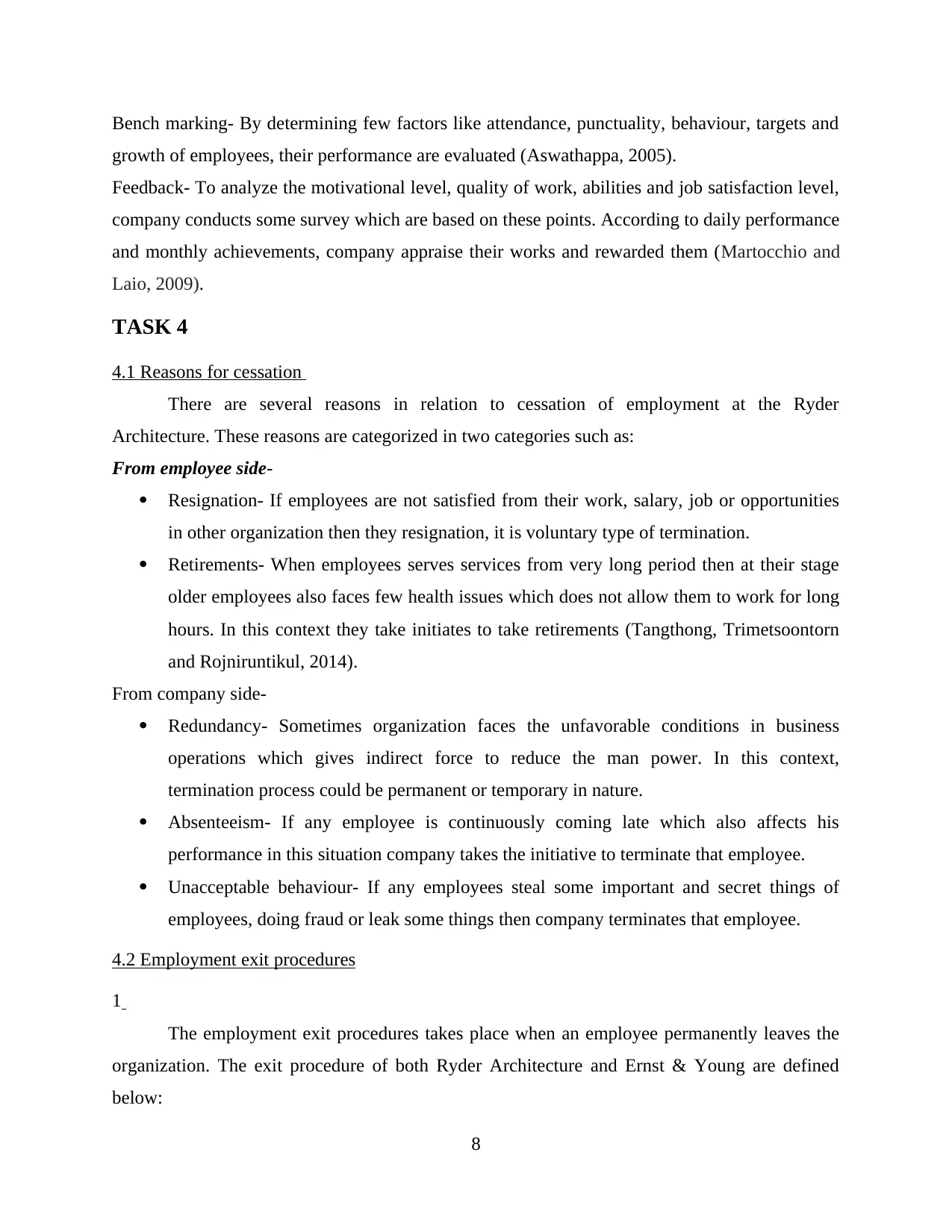
Bench marking- By determining few factors like attendance, punctuality, behaviour, targets and
growth of employees, their performance are evaluated (Aswathappa, 2005).
Feedback- To analyze the motivational level, quality of work, abilities and job satisfaction level,
company conducts some survey which are based on these points. According to daily performance
and monthly achievements, company appraise their works and rewarded them (Martocchio and
Laio, 2009).
TASK 4
4.1 Reasons for cessation
There are several reasons in relation to cessation of employment at the Ryder
Architecture. These reasons are categorized in two categories such as:
From employee side-
Resignation- If employees are not satisfied from their work, salary, job or opportunities
in other organization then they resignation, it is voluntary type of termination.
Retirements- When employees serves services from very long period then at their stage
older employees also faces few health issues which does not allow them to work for long
hours. In this context they take initiates to take retirements (Tangthong, Trimetsoontorn
and Rojniruntikul, 2014).
From company side-
Redundancy- Sometimes organization faces the unfavorable conditions in business
operations which gives indirect force to reduce the man power. In this context,
termination process could be permanent or temporary in nature.
Absenteeism- If any employee is continuously coming late which also affects his
performance in this situation company takes the initiative to terminate that employee.
Unacceptable behaviour- If any employees steal some important and secret things of
employees, doing fraud or leak some things then company terminates that employee.
4.2 Employment exit procedures
1
The employment exit procedures takes place when an employee permanently leaves the
organization. The exit procedure of both Ryder Architecture and Ernst & Young are defined
below:
8
growth of employees, their performance are evaluated (Aswathappa, 2005).
Feedback- To analyze the motivational level, quality of work, abilities and job satisfaction level,
company conducts some survey which are based on these points. According to daily performance
and monthly achievements, company appraise their works and rewarded them (Martocchio and
Laio, 2009).
TASK 4
4.1 Reasons for cessation
There are several reasons in relation to cessation of employment at the Ryder
Architecture. These reasons are categorized in two categories such as:
From employee side-
Resignation- If employees are not satisfied from their work, salary, job or opportunities
in other organization then they resignation, it is voluntary type of termination.
Retirements- When employees serves services from very long period then at their stage
older employees also faces few health issues which does not allow them to work for long
hours. In this context they take initiates to take retirements (Tangthong, Trimetsoontorn
and Rojniruntikul, 2014).
From company side-
Redundancy- Sometimes organization faces the unfavorable conditions in business
operations which gives indirect force to reduce the man power. In this context,
termination process could be permanent or temporary in nature.
Absenteeism- If any employee is continuously coming late which also affects his
performance in this situation company takes the initiative to terminate that employee.
Unacceptable behaviour- If any employees steal some important and secret things of
employees, doing fraud or leak some things then company terminates that employee.
4.2 Employment exit procedures
1
The employment exit procedures takes place when an employee permanently leaves the
organization. The exit procedure of both Ryder Architecture and Ernst & Young are defined
below:
8

Notice period- In Ryder Architecture notice period is only of 1 month but in Ernst & Young it is
of Two and half month. The importance of notice period in every organization that firm could
get substitute option to fill the gap.
Retaining method- If an employee is good performer then company offer him high authorities
options and better compensation to retain him. In Ryder, company offer s the compensation like
increment in salary whereas, Ernst & Young offers the senior authority designation to that
employee in next month (Vander-Klaauw and Van Ours, 2013).
Exit interview- Even after the retention's offer. Employee still wishes to leave the organization
then in this situation exit interview take place. The motive of this interview is to find out the
reason of termination. In Ernst & Young company this procedure is even more tough like older
employee has to train the newer ones etc.
Acceptance- When reason behind termination is identified and then company accepts the
resignation of employee (Snell, Morris and Bohlander, 2015).
4.3 Impact of both legal and
2 regulatory framework on employment
3 cessation arrangements
The legal and regulatory agreements gives impact on the employment cessation. In this
context, Ryder Architecture follows few laws related to employment cessation. An emplpoyee
could legally dismiss when:
Job termination with or without notice period.
Contract is not renewed at the end period with same policies and terms.
Employee has to give the notice period of resignation before 1 month.
Presence of employee tribunal bodies to solve conflicts related to unfair dismissal or
redundancy payment etc.
If employee does not inform the employee about resignation then in this situation firm can take
the legal action against that employee. It comes in the Employment Right Act 1996 (Shields,
Brown and Plimmer, 2015).
CONCLUSION
With the help of this report it is articulated that human resource management is an
important part of organization management which helps to enhance the performance and
9
of Two and half month. The importance of notice period in every organization that firm could
get substitute option to fill the gap.
Retaining method- If an employee is good performer then company offer him high authorities
options and better compensation to retain him. In Ryder, company offer s the compensation like
increment in salary whereas, Ernst & Young offers the senior authority designation to that
employee in next month (Vander-Klaauw and Van Ours, 2013).
Exit interview- Even after the retention's offer. Employee still wishes to leave the organization
then in this situation exit interview take place. The motive of this interview is to find out the
reason of termination. In Ernst & Young company this procedure is even more tough like older
employee has to train the newer ones etc.
Acceptance- When reason behind termination is identified and then company accepts the
resignation of employee (Snell, Morris and Bohlander, 2015).
4.3 Impact of both legal and
2 regulatory framework on employment
3 cessation arrangements
The legal and regulatory agreements gives impact on the employment cessation. In this
context, Ryder Architecture follows few laws related to employment cessation. An emplpoyee
could legally dismiss when:
Job termination with or without notice period.
Contract is not renewed at the end period with same policies and terms.
Employee has to give the notice period of resignation before 1 month.
Presence of employee tribunal bodies to solve conflicts related to unfair dismissal or
redundancy payment etc.
If employee does not inform the employee about resignation then in this situation firm can take
the legal action against that employee. It comes in the Employment Right Act 1996 (Shields,
Brown and Plimmer, 2015).
CONCLUSION
With the help of this report it is articulated that human resource management is an
important part of organization management which helps to enhance the performance and
9
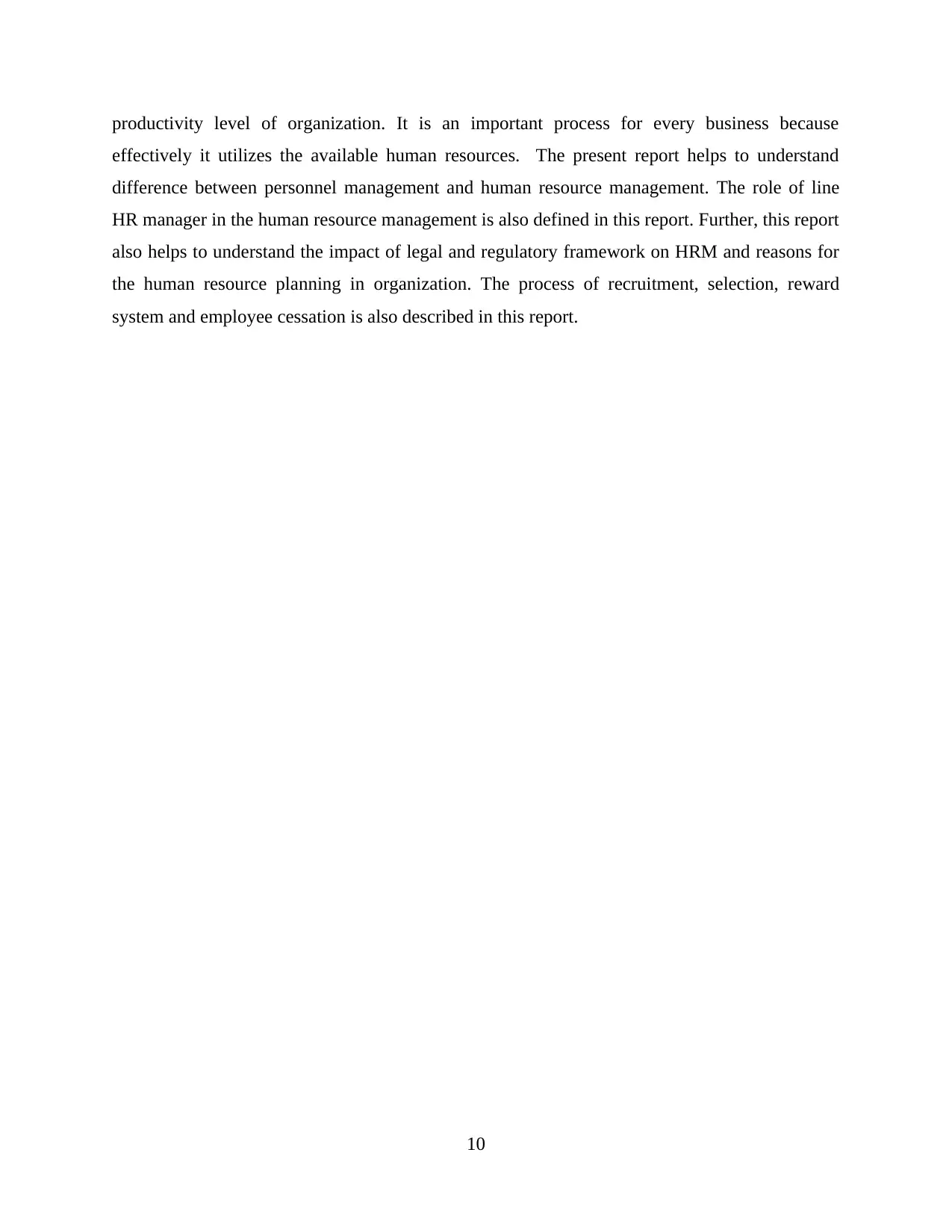
productivity level of organization. It is an important process for every business because
effectively it utilizes the available human resources. The present report helps to understand
difference between personnel management and human resource management. The role of line
HR manager in the human resource management is also defined in this report. Further, this report
also helps to understand the impact of legal and regulatory framework on HRM and reasons for
the human resource planning in organization. The process of recruitment, selection, reward
system and employee cessation is also described in this report.
10
effectively it utilizes the available human resources. The present report helps to understand
difference between personnel management and human resource management. The role of line
HR manager in the human resource management is also defined in this report. Further, this report
also helps to understand the impact of legal and regulatory framework on HRM and reasons for
the human resource planning in organization. The process of recruitment, selection, reward
system and employee cessation is also described in this report.
10
Paraphrase This Document
Need a fresh take? Get an instant paraphrase of this document with our AI Paraphraser
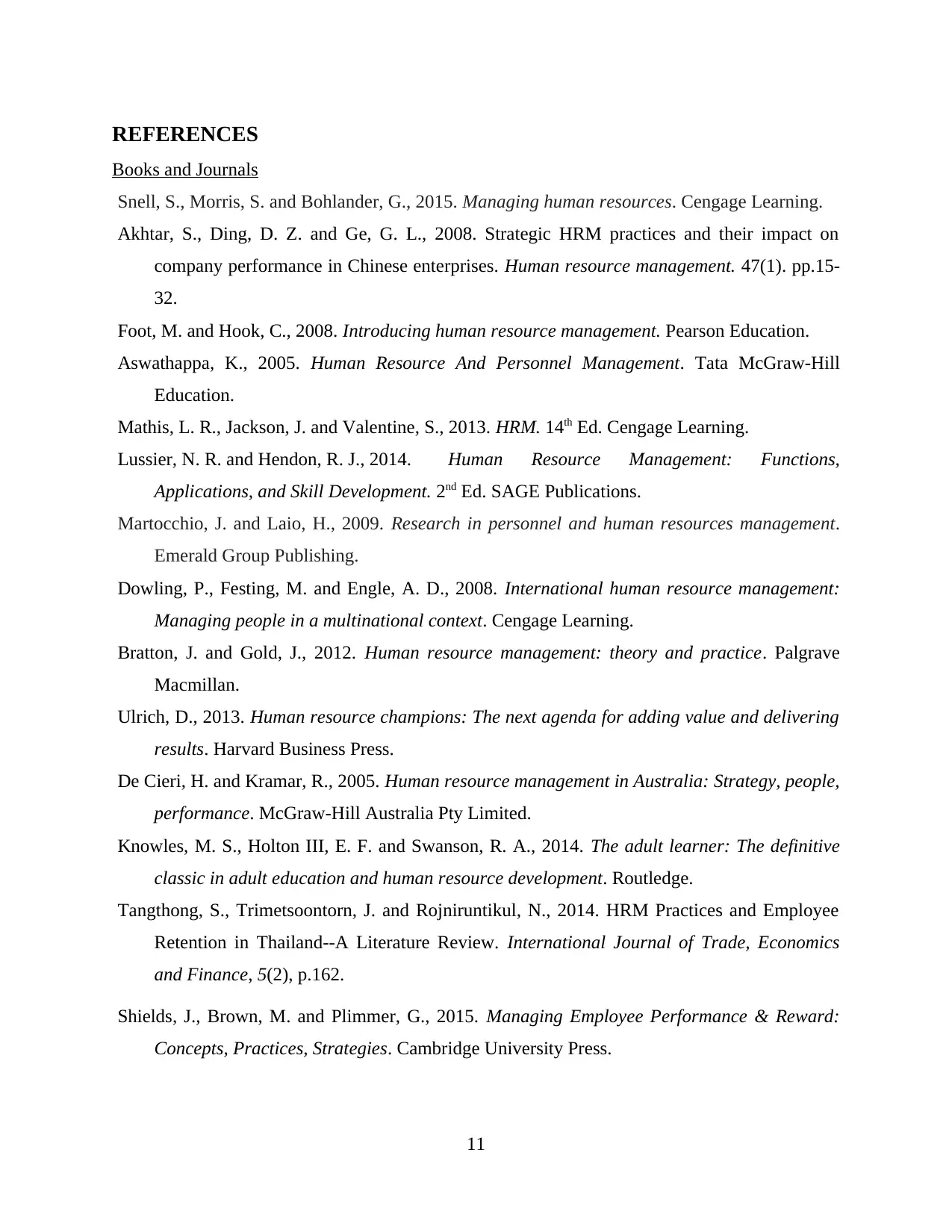
REFERENCES
Books and Journals
Snell, S., Morris, S. and Bohlander, G., 2015. Managing human resources. Cengage Learning.
Akhtar, S., Ding, D. Z. and Ge, G. L., 2008. Strategic HRM practices and their impact on
company performance in Chinese enterprises. Human resource management. 47(1). pp.15-
32.
Foot, M. and Hook, C., 2008. Introducing human resource management. Pearson Education.
Aswathappa, K., 2005. Human Resource And Personnel Management. Tata McGraw-Hill
Education.
Mathis, L. R., Jackson, J. and Valentine, S., 2013. HRM. 14th Ed. Cengage Learning.
Lussier, N. R. and Hendon, R. J., 2014. Human Resource Management: Functions,
Applications, and Skill Development. 2nd Ed. SAGE Publications.
Martocchio, J. and Laio, H., 2009. Research in personnel and human resources management.
Emerald Group Publishing.
Dowling, P., Festing, M. and Engle, A. D., 2008. International human resource management:
Managing people in a multinational context. Cengage Learning.
Bratton, J. and Gold, J., 2012. Human resource management: theory and practice. Palgrave
Macmillan.
Ulrich, D., 2013. Human resource champions: The next agenda for adding value and delivering
results. Harvard Business Press.
De Cieri, H. and Kramar, R., 2005. Human resource management in Australia: Strategy, people,
performance. McGraw-Hill Australia Pty Limited.
Knowles, M. S., Holton III, E. F. and Swanson, R. A., 2014. The adult learner: The definitive
classic in adult education and human resource development. Routledge.
Tangthong, S., Trimetsoontorn, J. and Rojniruntikul, N., 2014. HRM Practices and Employee
Retention in Thailand--A Literature Review. International Journal of Trade, Economics
and Finance, 5(2), p.162.
Shields, J., Brown, M. and Plimmer, G., 2015. Managing Employee Performance & Reward:
Concepts, Practices, Strategies. Cambridge University Press.
11
Books and Journals
Snell, S., Morris, S. and Bohlander, G., 2015. Managing human resources. Cengage Learning.
Akhtar, S., Ding, D. Z. and Ge, G. L., 2008. Strategic HRM practices and their impact on
company performance in Chinese enterprises. Human resource management. 47(1). pp.15-
32.
Foot, M. and Hook, C., 2008. Introducing human resource management. Pearson Education.
Aswathappa, K., 2005. Human Resource And Personnel Management. Tata McGraw-Hill
Education.
Mathis, L. R., Jackson, J. and Valentine, S., 2013. HRM. 14th Ed. Cengage Learning.
Lussier, N. R. and Hendon, R. J., 2014. Human Resource Management: Functions,
Applications, and Skill Development. 2nd Ed. SAGE Publications.
Martocchio, J. and Laio, H., 2009. Research in personnel and human resources management.
Emerald Group Publishing.
Dowling, P., Festing, M. and Engle, A. D., 2008. International human resource management:
Managing people in a multinational context. Cengage Learning.
Bratton, J. and Gold, J., 2012. Human resource management: theory and practice. Palgrave
Macmillan.
Ulrich, D., 2013. Human resource champions: The next agenda for adding value and delivering
results. Harvard Business Press.
De Cieri, H. and Kramar, R., 2005. Human resource management in Australia: Strategy, people,
performance. McGraw-Hill Australia Pty Limited.
Knowles, M. S., Holton III, E. F. and Swanson, R. A., 2014. The adult learner: The definitive
classic in adult education and human resource development. Routledge.
Tangthong, S., Trimetsoontorn, J. and Rojniruntikul, N., 2014. HRM Practices and Employee
Retention in Thailand--A Literature Review. International Journal of Trade, Economics
and Finance, 5(2), p.162.
Shields, J., Brown, M. and Plimmer, G., 2015. Managing Employee Performance & Reward:
Concepts, Practices, Strategies. Cambridge University Press.
11

Vander-Klaauw, B. and Van Ours, J.C., 2013. Carrot And Stick: How Re‐Employment Bonuses
And Benefit Sanctions Affect Exit Rates From Welfare. Journal of Applied Econometrics,
28(2), pp.275-296.
Bernardin, H.J. and Wiatrowski, M., 2013. Performance appraisal. Psychology and Policing,
257.
Online
Ryder Architecture, 2016. Available through: <http://www.b.co.uk/Company/Profile/205173/>.
[Accessed on 22nd February 2016].
Susan. M., 2010. What is human resource management. [Online]. Available through:
<http://humanresources.about.com/od/glossaryh/f/hr_management.htm>. [Accessed on 22nd
February 2016].
12
And Benefit Sanctions Affect Exit Rates From Welfare. Journal of Applied Econometrics,
28(2), pp.275-296.
Bernardin, H.J. and Wiatrowski, M., 2013. Performance appraisal. Psychology and Policing,
257.
Online
Ryder Architecture, 2016. Available through: <http://www.b.co.uk/Company/Profile/205173/>.
[Accessed on 22nd February 2016].
Susan. M., 2010. What is human resource management. [Online]. Available through:
<http://humanresources.about.com/od/glossaryh/f/hr_management.htm>. [Accessed on 22nd
February 2016].
12
1 out of 15
Related Documents
Your All-in-One AI-Powered Toolkit for Academic Success.
+13062052269
info@desklib.com
Available 24*7 on WhatsApp / Email
![[object Object]](/_next/static/media/star-bottom.7253800d.svg)
Unlock your academic potential
© 2024 | Zucol Services PVT LTD | All rights reserved.





